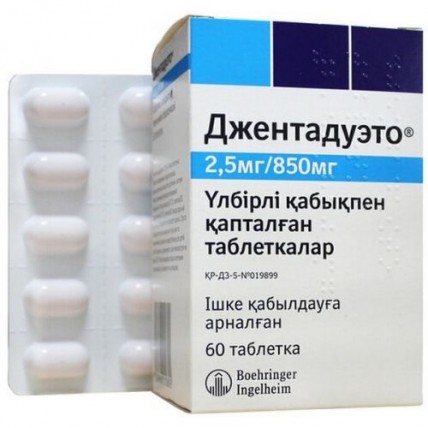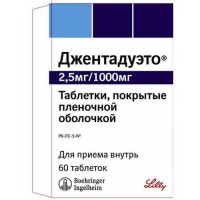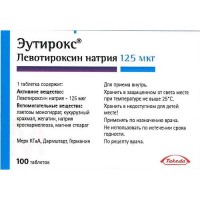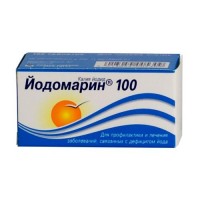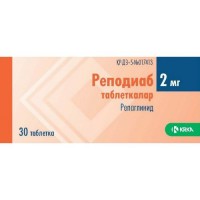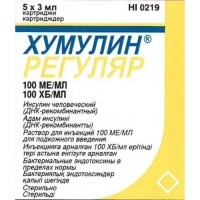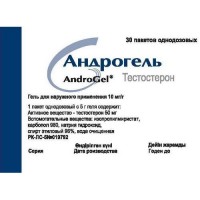Jentadueto® (Linagliptin/Metformin HCI) 2.5 mg/850 mg (60 film-coated tablets)
- $180.30
Sku:
138afa909916
Buy Jentadueto® (Linagliptin/Metformin HCI) 2.5 mg/850 mg (60 film-coated tablets)
DESCRIPTION
Film-coated tablets of light orange color, oval-shaped, with a biconvex surface, with the company logo engraved on one side and “D2 / 850” engraved on the other side (for dosage 2.5 mg / 850 mg) Film-coated tablets of light pink color, oval shape, with a biconvex surface, with the company logo engraved on one side and “D2 / 1000” engraved on the other side (for dosage 2.5 mg / 1000 mg).
INDICATIONS FOR APPLICATION OF JENTADUETO
Type 2 diabetes mellitus in order to improve glycemic control (in combination with diet and exercise) in cases where the simultaneous use of linagliptin and metformin is advisable: in patients whose treatment with metformin alone is not effective enough, or in patients who who are already receiving a combination of linagliptin and metformin as separate drugs with good effect. GENTADUETO may be prescribed in combination with sulfonylurea derivatives (triple combination therapy) in addition to diet and exercise in patients who are not effectively treated with metformin and sulfonylurea derivatives at maximum tolerated doses.
HOW TO APPLY JENTAUETO AND DOSES
For oral administration. The recommended dose is 2.5 mg / 850 mg or 2.5 mg / 1000 mg twice a day. Dosage should be selected individually based on the patient's current treatment regimen, its effectiveness and tolerability. The maximum recommended daily dose of JENTADUETO is 5 mg linagliptin and 2000 mg metformin. JENTADUETO should be taken with food to reduce the gastrointestinal side effects caused by metformin. For patients in whom type 2 diabetes mellitus is not sufficiently controlled by metformin monotherapy at the maximum tolerated dose, JEN-TADUETO should usually be prescribed in such a way that the dose of linagliptin is 2.5 mg twice a day (daily dose 5 mg). and the metformin dose remained the same as before. For patients who are transferred from the combined use of linagliptin and metformin, JENTADUETO should be prescribed in such a way that the doses of linagliptin and metformin are the same as before. For patients in whom type 2 diabetes mellitus is not sufficiently controlled by double combination therapy using the maximum tolerated doses of metformin and a sulfonylurea derivative, JEN-TADUETO should usually be prescribed in such a way that the dose of linagliptin is 2.5 mg twice a day. day (daily dose 5 mg), and the dose of metformin was the same as before. When JENTADUETO is used in combination with a sulfonylurea derivative, a lower dose of the sulfonylurea derivative may be required to reduce the risk of hypoglycemia. For the use of various doses of metformin, JENTADUETO is available in the following dosage forms: linagliptin 2.5 mg + metformin hydrochloride 850 mg or metformin hydrochloride 1000 mg. Renal dysfunction JENTADUETO (due to the presence of metformin in its composition) is contraindicated in patients with moderate or severe renal dysfunction (creatinine clearance <60 ml / min). Liver dysfunction JENTADUETO (due to the presence of metformin in its composition) is contraindicated in patients with hepatic insufficiency. In elderly patients Since metformin is excreted by the kidneys, and elderly patients tend to decrease renal function, in elderly patients taking JENTADUETO, it is necessary to regularly monitor renal function. Missed dose If a drug is missed, it should be taken as soon as the patient remembers. Do not take a double dose at the same time.
CONTRAINDICATIONS JENTADUETO
In patients who received a combination of linagliptin and metformin in fixed doses: Often, decreased appetite, diarrhea, nausea, hypoglycemia Uncommon, nasopharyngitis, bronchial hyperactivity, increased amylase activity, hypersensitivity (angioedema, urticaria, rash) Rarely headache, dizziness, vomiting who received metformin monotherapy: Often taste disorders abdominal pain hepatobiliary disorders: changes in liver function indicators, hepatitis erythema, urticaria Rarely metabolic disorders: lactic acidosis, impaired absorption of vitamin B12 (with long-term treatment) can lead (in very rare cases) to clinically significant vitamin B12 deficiency, such as megaloblastic anemia
PHARMACOLOGY
Pharmacokinetics Bioequivalence studies conducted in healthy volunteers have shown that JENTADUETO is bioequivalent to linagliptin and metformin used separately. The use of JENTADUETO with food did not lead to a change in the pharmacokinetic parameters of linagliptin. The area under the concentration-time curve (AUC) of metformin did not change, but the average maximum concentration (Cmax) of metformin in serum in the case of administration of the drug with food decreased by 18%. In the case of using the drug with food, there was an increase in the time to reach the maximum concentration of metformin in serum by 2 hours. The clinical significance of these changes is unlikely. Below are the provisions reflecting the pharmacokinetic properties of the individual active components of JENTADUETO. Linagliptin After oral administration of linagliptin at a dose of 5 mg, the drug was rapidly absorbed, peak plasma concentrations (median Tmax) were reached after 1.5 hours. Plasma concentrations of linagliptin decrease in two phases. The terminal half-life is long (more than 100 hours), which is mainly due to the saturable, stable binding of linagliptin to DPP-4 and does not lead to drug accumulation. The effective half-elimination half-life for the accumulation of linagliptin, determined after repeated administration of linagliptin at a dose of 5 mg, is approximately 12 hours. In the case of taking linagliptin at a dose of 5 mg once a day, stable plasma concentrations of the drug were achieved after the third dose, while the AUC of linagliptin in plasma increased by about 33% compared to the first dose. Coefficients of variation for linagliptin AUC were small (12.6% and 28.5%, respectively). Plasma AUC values for linagliptin increased less proportionally with increasing doses. The pharmacokinetics of linagliptin in healthy people and patients with type 2 diabetes mellitus were, in general, similar. Absorption The absolute bioavailability of linagliptin is approximately 30%. Since the intake of linagliptin along with food containing a large amount of fat did not have a clinically significant effect on pharmacokinetics, linagliptin can be used both with food and without regard to food intake. In vitro studies have shown that linagliptin is a substrate for glycoprotein-P and CYP3A4. Ritonavir, a potent inhibitor of P-glycoprotein and CYP3A4, resulted in a twofold increase in the exposure (assessed by AUC) to linagliptin, and repeated administration of linagliptin with rifampicin, a potent inducer of P-gp and CYP3A, led to a decrease in the AUC of linagliptin by approximately 40 %, mainly due to an increase (or, accordingly, a decrease) in the bio-availability of linagliptin due to inhibition (or, respectively, induction) of glycoprotein-P. Distribution The average volume of distribution after a single dose of 5 mg is approximately 1110 liters, indicating extensive tissue distribution. The binding of linagliptin to plasma proteins depends on the concentration of the drug. If the concentration is 1 nmol / L, the binding is about 99%, and with an increase in the concentration of linagliptin to ≥30 nmol / L, binding decreases to 75-89%, which reflects the saturation of the drug's bond with DPP-4 as the concentration of linagliptin increases.... At high concentrations of linagliptin, when the binding to DPP-4 is completely saturated, 70-80% of linagliptin bound to other plasma proteins, and 30-20% of the drug was in a free state. Metabolism and excretion A small part of the drug entering the body is metabolized. The predominant route of excretion is through the intestines (about 85%). Approximately 5% of linagliptin is excreted in the urine. One major metabolite of the drug was identified, the relative effect of which in the stationary phase was 13.3% of that of linagliptin. This metabolite has no pharmacological activity and does not contribute to the inhibitory activity of linagliptin against plasma DPP-4. Renal clearance is approximately 70 ml / min. Patients with renal insufficiency In patients with any degree of renal insufficiency, changes in the dosage of linagliptin are not considered necessary. Minor renal impairment did not affect the pharmacokinetics of linagliptin in patients with type 2 diabetes. Patients with hepatic impairment In patients with mild, moderate or severe hepatic impairment, no changes in the dosage of linagliptin are required. Children Studies of the pharmacokinetics of linagliptin in children have not been conducted. Dosage changes depending on gender, body mass index (BMI), race, age of patients are not required. Metformin Absorption After oral administration of metformin, the maximum concentration (Cmax) is reached after 2.5 hours. In healthy volunteers, the absolute bioavailability of metformin hydrochloride after oral administration at a dose of 850 mg is approximately 50-60%. After taking the drug inside about 20-30% of the drug is not absorbed and excreted by the intestines unchanged. Metformin hydrochloride is characterized by non-linear absorption pharmacokinetics. When the recommended doses of metformin hydrochloride are used, steady-state plasma concentrations are achieved within 24-48 hours and are usually less than 1 μg / ml. Food decreases the degree of absorption of metformin hydrochloride and slightly slows down the rate of absorption. After using the drug at a dose of 850 mg with food intake, the maximum plasma concentration (Cmax) was 40% less, the area under the concentration-time curve (AUC) was 25% less, and the time elapsed before reaching the maximum concentration in plasma increased by 35 minutes. The clinical significance of a decrease in these rates is unknown. Distribution Plasma protein binding of metformin is negligible. Metformin hydrochloride binds to erythrocytes. The maximum concentration of the drug in the blood is lower than in the plasma and is reached approximately simultaneously. It is assumed that erythrocytes are an additional compartment for drug distribution. The average volume of distribution (Vd) varies from 63 to 276 liters. Metabolism Metformin hydrochloride is excreted by the kidneys unchanged. In humans, drug metabolites have not been identified. Excretion The renal clearance of metformin hydrochloride exceeds 400 ml / min, which indicates the elimination of the drug by glomerular filtration and tubular secretion. After oral administration, the terminal half-elimination period is approximately 6.5 hours. In case of impaired renal function, the renal clearance of the drug decreases in proportion to the creatinine clearance, therefore the half-life is lengthened, which leads to an increase in the level of metformin hydrochloride in plasma. Children After a single administration of metformin at a dose of 500 mg in children, the pharmacokinetic profile was similar to that in healthy adults. After repeated use of the drug at a dose of 500 mg twice a day for 7 days in children with diabetes, the maximum plasma concentration (Cmax) and systemic exposure (AUC0-t) were approximately 33% and 40% less than in adult patients with diabetes mellitus who received metformin at a dose of 500 mg twice a day for 14 days. Since the dose of the drug is selected individually depending on the degree of glycemic control, these data are of limited clinical significance. Pharmacodynamics JENTADUETO is a fixed combination of two self-lowering compounds - linagliptin and metformin hydrochloride. Linagliptin is an inhibitor of the DPP-4 (dipeptidyl peptide-a-4, code EC 3.4.14.5) enzyme, which is involved in the inactivation of incretin hormones - glucagon-like peptide-1 (GLP-1) and glucose-dependent insulinotropic polypeptide (GIP). These hormones are rapidly destroyed by the DPP-4 enzyme. Both of these incretins are involved in the physiological regulation of glucose homeostasis. The basal level of incretin secretion during the day is low, it rises rapidly after eating. GLP-1 and GIP enhance insulin biosynthesis and secretion by pancreatic beta cells in the presence of normal and elevated blood glucose levels. In addition, GLP-1 reduces the secretion of glucagon by pancreatic alpha cells, which leads to a decrease in glucose production in the liver. Linagliptin effectively and reversibly binds to DPP-4, which causes a sustained increase in incretin levels and long-term maintenance of their activity. Linagliptin increases insulin secretion depending on glucose levels and decreases glucagon secretion, resulting in an improvement in glucose homeostasis. Linagliptin binds to DPP-4 selectively, in vitro its selectivity exceeds the selectivity for DPP-8 or activity against DPP-9 by more than 10,000 times. Linagliptin treatment significantly improves surrogate markers of beta cell function, including HOMA (a model for assessing homeostasis), proinsulin to insulin ratio, and beta cell response rates as measured by food tolerance tests. Metformin is a biguanide and has a hypoglycemic effect, lowering basal and postprandial plasma glucose levels. Met-formin does not stimulate insulin secretion and therefore does not lead to hypo-glycemia. Metformin hydrochloride has 3 mechanisms of action: 1. reducing the formation of glucose in the liver by inhibiting gluconeogenesis and glycogenolysis 2. increasing glucose consumption by skeletal muscles and its utilization by increasing insulin sensitivity 3. slowing down the absorption of glucose in the intestine. Metformin stimulates intracellular glycogen synthesis by acting on glycogen synthetase. Metformin hydrochloride increases the transport capacity of all types of currently known membrane glucose transporters. Metformin hydrochloride in humans, regardless of the effect on glycemia, has a beneficial effect on lipid metabolism: it reduces the level of total cholesterol, LDL cholesterol and triglycerides. Adding linagliptina to metformin therapy The efficacy and safety of linagliptin, used in combination with metformin in patients with glycemia that was not sufficiently controlled by metformin monotherapy, has been studied in a number of double-blind, placebo-controlled studies. The combination of linagliptin and metformin provides a significant and reliable improvement in glycemic parameters without changing body weight than taking each of the components separately. In particular, the level of glycosylated hemoglobin A (HbA1c), fasting plasma glucose (FPG), and plasma glucose levels 2 hours after a meal (GLP) decrease significantly. Cardiovascular Risk A prospective meta-analysis of 5,239 type 2 diabetes patients who participated in 8 clinical trials showed that treatment with linagliptin did not increase cardiovascular risk (cardiovascular death, nonfatal myocardial infarction, nonfatal stroke, or hospitalization in connection with unstable angina).
DRUG INTERACTIONS
The simultaneous repeated use of linagliptin (10 mg once a day) and metformin (850 mg twice a day) in healthy volunteers did not significantly change the pharmacokinetics of linagliptin or metformin. Pharmacokinetic studies of drug interactions JEN-TADUETO have not been conducted; however, such studies have been conducted with the individual active ingredients of JENTADUETO, linagliptin and metformin. Linagliptin did not have a clinically significant effect on the pharmacokinetics of metformin, glibenclamide, simvastatin, pioglitazone, warfarin, di-goxin and oral contraceptives, which was consistent with in vivo data on the low ability to drug interactions with substrates for CYP3A4 isoenzymes, CYP2C9, CYP2C8, glycoprotein-P and organic cation transporter (TOC). Metformin. The simultaneous use of metformin (repeated use at a dose of 850 mg 3 times a day) and linagliptin (at a supratherapeutic dose of 10 mg once a day) does not lead to clinically significant changes in the pharmacokinetics of linagliptin or metformin. Sulfonylurea derivatives. The combined use of linagliptin orally (multiple doses of 5 mg) and a single dose of glibenclamide (glyburide, 1.75 mg) does not change the pharmacokinetics of linagliptin in the stationary period. However, there is a clinically insignificant decrease in AUC and Cmax of glibenclamide by 14%. Since glibenclamide is metabolized mainly by CYP2C9, these data also support the conclusion that linagliptin is not an inhibitor of CYP2C9. Clinically significant interactions are not expected with other sulfonylurea derivatives (for example, glipizide, tolbutamide and glimepiride), which, like glibenclamide, are mainly metabolized with the participation of CYP2C9. Thiazolidinediones. The combined use of linagliptin (once 10 mg per day) and pioglitazone (multiple doses of 45 mg per day), which is a substrate for CYP2C8 and CYP3A4, does not have a clinically significant effect on the pharmacokinetics of linagliptin or pioglitazone, or active metabolites pioglitazone. Ritonavir. The combined use of linagliptin (a single dose of 5 mg orally) and ritonavir (a multiple dose of 200 mg orally) increases the AUC and Cmax of linagliptin, approximately two and three times, respectively. These changes in the pharmacokinetics of linagliptin are not considered clinically significant. Therefore, clinically significant interactions with other P-glycoprotein / CYP3A4 inhibitors are not expected and no dosage changes are required. Rifampicin. Repeated combined use of linagliptin and rifam-picin leads to a decrease in the AUC and Cmax of linagliptin in the stationary period of pharmacokinetics by 39.6% and 43.8%, respectively, and to a decrease in inhibition of the basal DPP-4 activity by about 30%. Thus, it is expected that the clinical efficacy of linagliptin in combination with active P-gp inducers will be maintained, although it may not be fully manifested. Digoxin. The combined repeated use of linagliptin (5 mg / day) and digoxin (0.25 mg / day) does not affect the pharmacokinetics of digoxin. Warfarin. Linagliptin, used repeatedly at a dose of 5 mg per day, did not alter the pharmacokinetics of S (-) or R (+) warfarin, which is a substrate for CYP2C9, which indicates that linagliptin lacks the ability to inhibit CYP2C9. Simvastatin. Linagliptin, used repeatedly at a supertherapeutic dose of 10 mg per day, has a minimal effect on the pharmacokinetics of simvastatin, which does not require dosage adjustment. Oral contraceptive drugs. The combined use of linagliptin at a dose of 5 mg with levonorgestrel or ethinyl estradiol does not change the pharmacokinetics of these drugs in the stationary period. Metformin. The use of metformin during acute alcohol intoxication increases the risk of developing lactic acidosis (especially in the case of starvation, malnutrition, or liver failure). Avoid the use of alcohol and medications containing ethyl alcohol. Cationic drugs that are cleared by renal tubular secretion (eg, cimetidine) may interact with metformin to compete for shared renal tubular transport systems. Therefore, with the simultaneous use of cationic drugs that are excreted by renal tubular secretion, careful control of glycemia, a change in the dose of metformin within the recommended dosage regimen and (if necessary) correction of diabetes mellitus therapy is required.
